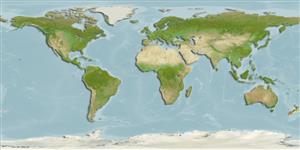>
Blenniiformes (Blennies) >
Tripterygiidae (Triplefin blennies) > Tripterygiinae
Etymology: Apopterygion: Greek, apo = outside + Greek, pterygion = diminutive of pteryx = fin (Ref. 45335); oculus: Oculus (Latin) means "eye", and refers to the ocellate black bloch on the second dorsal fin..
More on authors: Fricke & Roberts.
Environment: milieu / climate zone / depth range / distribution range
Écologie
marin démersal; non migrateur; profondeur 14 - 186 m (Ref. 13227). Temperate
Southwest Pacific: endemic to New Zealand.
Taille / Poids / Âge
Maturity: Lm ? range ? - ? cm
Max length : 6.3 cm SL mâle / non sexé; (Ref. 13227)
Description synthétique
Clés d'identification | Morphologie | Morphométrie
Épines dorsales (Total) : 16 - 19; Rayons mous dorsaux (Total) : 9 - 13; Épines anales: 2; Rayons mous anaux: 20 - 26. 19-25 pored scales in the anterior lateral line series, 16-20 notched scales in the posterior series, the second dorsal fin with an ocellate black blotch distally on 4th-6th membranes, the anal fin with about 11 dark streaks, the pelvic fin basally black, rays distally yellowish, with brown spots, and the dorsal fin spines densely covered with small spinules.
Adults are said to be associated with red coralline gravel and shell substrates (Ref. 13227). Eggs are hemispherical and covered with numerous sticky threads that anchor them in the algae on the nesting sites (Ref. 240). Larvae are planktonic which occur primarily in shallow, nearshore waters (Ref. 94114).
Life cycle and mating behavior
Maturities | Reproduction | Spawnings | Egg(s) | Fecundities | Larves
Fricke, R., 1994. Tripterygiid fishes of Australia, New Zealand and the southwest Pacific Ocean (Teleostei). Theses Zool. 24:1-585. (Ref. 13227)
Statut dans la liste rouge de l'IUCN (Ref. 130435)
Menace pour l'homme
Harmless
Utilisations par l'homme
Pêcheries: sans intérêt
Outils
Articles particuliers
Télécharger en XML
Sources Internet
Estimates based on models
Preferred temperature (Ref.
123201): 8.8 - 15.6, mean 12 °C (based on 36 cells).
Phylogenetic diversity index (Ref.
82804): PD
50 = 0.7500 [Uniqueness, from 0.5 = low to 2.0 = high].
Bayesian length-weight: a=0.00794 (0.00346 - 0.01822), b=3.08 (2.88 - 3.28), in cm total length, based on LWR estimates for this (Sub)family-body shape (Ref.
93245).
Niveau trophique (Ref.
69278): 3.2 ±0.4 se; based on size and trophs of closest relatives
Résilience (Ref.
120179): Haut, temps minimum de doublement de population inférieur à 15 mois (Preliminary K or Fecundity.).
Fishing Vulnerability (Ref.
59153): Low vulnerability (10 of 100).
